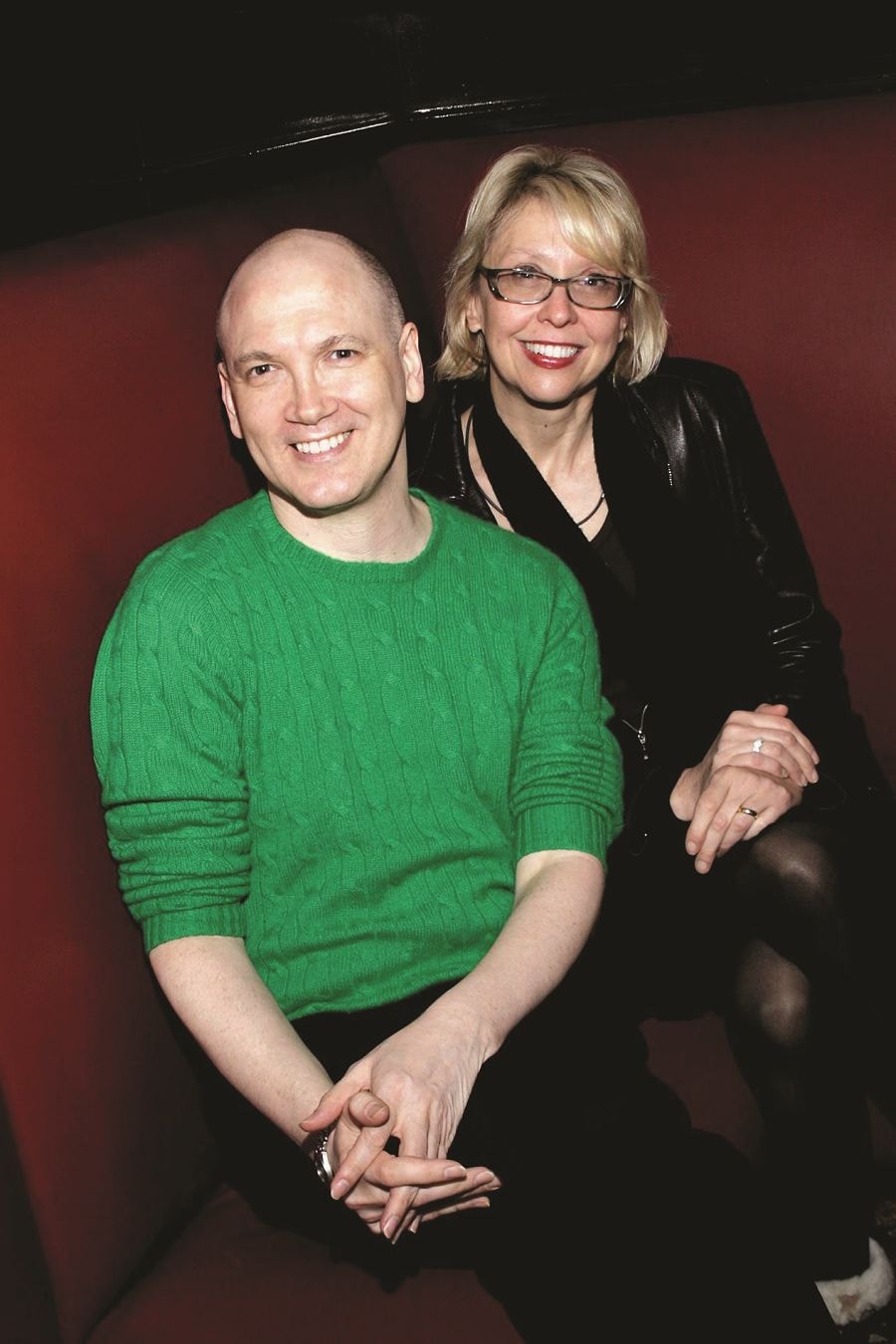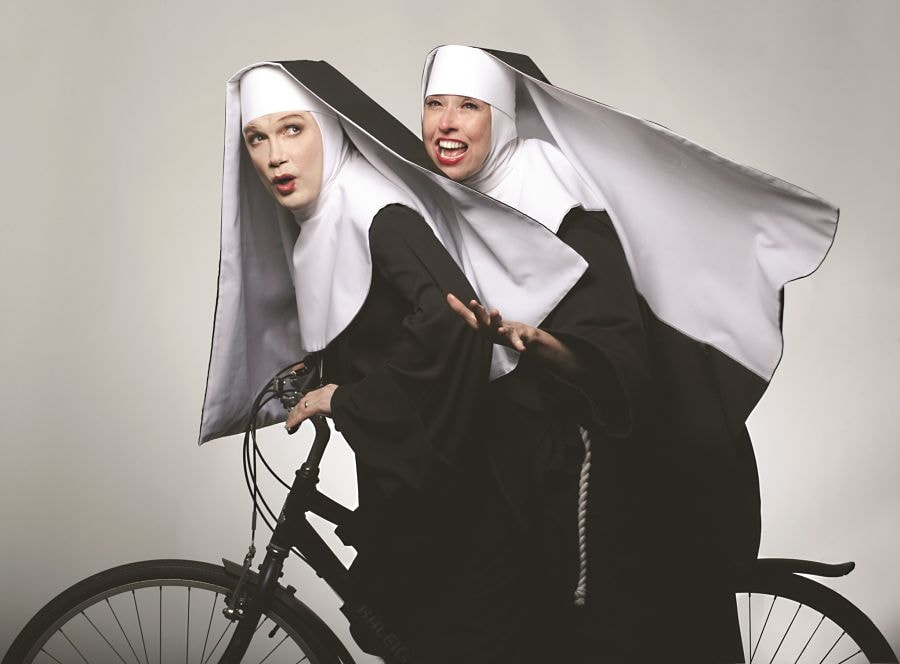Charles Busch and Julie Halston first appeared onstage together 29 years ago, as rival undead divas in Busch’s breakthrough hit Vampire Lesbians of Sodom, and they have been partners in comic mayhem ever since.
During the heyday of Theatre-in-Limbo, Busch’s on-again-off-again repertory company, Halston convulsed Off-Off-Broadway audiences in a variety of roles, especially as a wisecracking ex-vaudevillian surrounded by Nazis in The Lady in Question and as a Commie-baiting radio star in Red Scare on Sunset. More recently, she scored as a boxing promoter turned Bride of Christ (with paranoia issues) in The Divine Sister, and as a Good Samaritan who turns nasty under the influence of the caustic title character in Olive and the Bitter Herbs. As we go to press, Busch and Halston are laying plans for The Tribute Artist, scheduled to run later this season at New York City’s Primary Stages.
The two first crossed paths in the early ’80s, when Busch caught Halston performing in a San Francisco cabaret. “It was the most miserable act,” Busch recounts (Halston agrees), “because she didn’t know who she was. I didn’t get it. She was a big personality offstage!”
By 1984, Halston was back in NYC, working on Wall Street, and Busch’s own solo touring career was at a low point. Busch and the director Kenneth Elliott put together a comic sketch about dueling lady vampires through the ages, designed for the downtown Manhattan club Limbo Lounge. Vampire Lesbians wowed the crowd. But when the show was slated for a return engagement, Busch’s big casting coup—the inimitable Lola Pashalinski, of Charles Ludlam’s Ridiculous Theatrical Company—was unavailable. “I was desperate to find another leading lady,” Busch says. “My own sister turned me down! My last resort was that unfunny girl who worked on Wall Street. I called her up and asked, ‘Have you ever acted before?’ She said, ‘I’ve done Nina in The Seagull at Hofstra.’”
Both agree that rehearsals for the show were a disaster. But, as Busch tells it, Halston made a speech to the company, saying, “Listen; I know I stink—but put me in a wig in front of 60 gay men and I glow.” And, Busch marvels, “She did!” Halston recalls it this way: “I was grand and fabulous and hilarious, and Charles and the rest of the cast were, like, who the hell is this? She didn’t show up to rehearsal!”
Egged on by the rest of the company, Busch wrote Halston into his next Limbo epic, Theodora, She-Bitch of Byzantium. This time he tapped into Halston’s essential personality, what she calls “that loud, crazy girl from Commack.” “I wrote the role of the dowager empress, Countess Vulva, around her speech patterns, and it liberated her for the first time,” Busch reports. “I have this terrible Long Island accent,” interjects Halston. “For years, I tried to get rid of it, until Charles said, ‘Darling, your accent is your fortune. Do not get rid of it. When I write a high-toned speech for you and you say it in that accent, people are going to laugh.’”
Of course, there was more to it than that. “I learned from Charles how to speak MGM-speak,” says Halston. “If I was going to play his soubrette, I had to learn the rhythms of Joan Blondell, Eve Arden, Rosalind Russell—those fast-talking gals. Not to sound arrogant, but there are so many performers today who don’t know how to do it. Charles’s rhythms are very similar to Kaufman and Hart’s. You have to know how to do that rhythm, and if you don’t, it will be a disaster.”
Halston is quick to add that Busch’s work is sometimes unfairly dismissed as a collection of campy drag sketches. “I hope that people come to appreciate what a rich, complex playwright he is—his plays are parodies, but that does not mean they are fluff. They grapple with interesting social issues. We are redefining gender.” And she further makes her case by noting how, for example, Shanghai Moon, Busch’s spoof of such Hollywood Orientalia as The Shanghai Gesture and The Letter, “takes Asian stereotypes and turns them on their ear.”

Over the years, Busch pushed Halston to take on new challenges. “We were doing Red Scare, the last Limbo play, and she had been telling me that she wanted to try a solo show again now that she knew herself better. She fantasized about it, but committing to it was hard. One day, I was walking past the cabaret Eighty-Eights—I knew Irv Raible, who ran it, so I went in and said, ‘There’s this actress, Julie Halston—she’s so funny, she’s putting together an act, and you should book her.’ We looked at the calendar and chose the date. I got to the theatre that night and said, ‘By the way, Julie, you’re booked at Eighty-Eights.’ She couldn’t believe it, but she rose to the bait.” This led to the one-woman show, Julie Halston’s Lifetime of Comedy, numerous Broadway gigs (including a show-stopping appearance as Electra in the 2003 Sam Mendes Gypsy revival), and plenty of film and TV work.
In The Tribute Artist, coming up Jan. 21–March 2 at 59E59, Busch and Halston are once again sidekicks up to their necks in trouble. “I play a female impersonator in a Vegas revue who is let go because he’s too old to play Beyoncé and Katy Perry,” says Busch. “Julie is my best friend, a third-rate real-estate agent. We devise a get-rich-quick scheme that goes awry.” Halston adds, “Charles and I always talk about, if we weren’t writers and actors, what would we be? So he’s written a play that is a response to what could have been for us.”
Both admit to going through a period of estrangement in the early ’90s, when Theatre-in-Limbo was traumatized by the AIDS-related deaths of several key players just as Halston’s solo career was taking off. But those days are long past, and today their collaboration seems as fruitful as ever. Busch says, “At this point, I often quote her directly in her dialogue.” Halston concurs, adding they’ll be having a conversation and “I’ll see it in his eyes—and something we’ve talked about ends up in a script.”
The secret, Halston says, is that the chemical reaction between their singular personalities yields something special. “I’m the Catholic girl from Commack who desperately wants to be a Jew. He’s the Jewish boy from Westchester who desperately wants to be a Catholic nun. The two of us together created a third person.” She adds, laughing, “Together we represent the entire Judeo-Christian heritage!”
David Barbour is the editor in chief of Lighting & Sound America.


